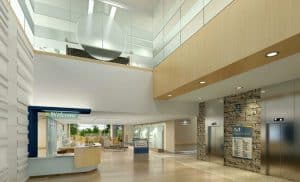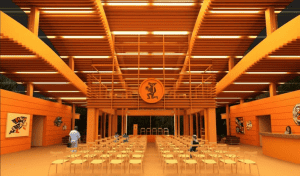
You are sitting in a restaurant surrounded by some of your best friends. The food is great and the drinks are cold. The restaurant is gradually getting busier. Between the chatter and the background music, you begin to raise your voice to be heard by those at your table. You are not alone in this. Almost everyone else is doing the same. The background chatter gets louder and louder as everyone in the room also raises their voice to be heard. This is the Lombard Effect: the tendency for humans to raise their voice in the presence of noise.

The background chatter gets louder and louder as everyone in the room also raises their voice to be heard. This is the Lombard Effect: the tendency for humans to raise their voice in the presence of noise.
While it is hard to know the extent to which a noisy eating environment can adversely affect a business, noise can be a major concern for certain customers and owners. In some restaurants, a loud environment is preferred so that the customers will be discouraged from spending too much time in the space. However, there are other restaurants in which a relaxing ambient environment is preferred. Nevertheless, in an eating space under normal conditions, most of the time, the customers want to be able to verbally engage in conversation with their companions. As a result, regardless of the type of restaurant, the acoustic characteristics of the space should be such that customers do not need to over exert themselves when speaking.

As a result, regardless of the type of restaurant, the acoustic characteristics of the space should be such that customers do not need to over exert themselves when speaking.
In an eating space, building services, background music, and most importantly, human-related activities such as talking, make the greatest contribution to the ambient noise level. The amount by which a source contributes to the ambient noise level is controlled by two factors: reverberation time (RT), and loudness of the source.
Reverberation time is a measure of the time it takes for sound to decay by a fixed amount (60 dB). If reverberation time is high, it takes a relatively long time for an unwanted sound to dissipate from a space. As a result, in spaces with high RTs, high levels of ambient noise can be expected if there are enough noisy activities taking place in the room. Moreover, louder noise sources create more ‘unwanted’ sounds that also result in high levels of ambient noise.
It is the ratio of a desired sound (the conversation to be conveyed) to all unwanted sounds that specifies how easily a conversation is audible. If the level of unwanted sounds is high, then to have a relatively acceptable audible conversation, one must speak louder. However, in a shared environment like a restaurant, speaking louder introduces more unwanted sounds for people who are not part of that conversation.

The above two way relationship, essentially puts a limit on the number of patrons who can occupy an eating space such that the ambient noise level will not exceed tolerable levels. However, if the ambient level is too high, reducing the number of occupants in order to achieve a better quality of verbal communication would be an unacceptable option for most restaurant owners. A better option would be to decrease the ambient level by decreasing the room’s RT (i.e. make the room less reverberant so that the room can get rid of unwanted sounds faster than before). This can be achieved by the addition of sound absorptive materials to available interior surfaces (i.e. walls, ceiling, floors, seats etc.).

However, some practical concepts, such as Acoustical Capacity, exist for the purpose of acoustic design and evaluation.
Now, the question is how much reverberation is allowable in a space with a certain number of patrons. Unfortunately, unlike many other types of interior spaces (e.g. lecture halls, theatres, classrooms), there is not much literature available on the desirable acoustical performance standards of eating spaces. However, some practical concepts, such as Acoustical Capacity, exist for the purpose of acoustic design and evaluation.
Acoustical Capacity of a space is defined as “the maximum number of people allowed in a room for ’Sufficient’ quality of verbal communication” [1]. Acoustical Capacity is dependent on the volume of an eating space and the reverberation time (RT):

There are basically two ways to interpret the above equation. To reach a desired number of occupants in an eating space without compromising speech audibility, either the reverberation time must be decreased (as already explained) or the volume must be increased (which is usually not a practical solution).

Figure 1: 3D model of a restaurant with no acoustical treatment
To illustrate the benefit of an Acoustic Capacity upgrade, consider the example of the restaurant shown in Figure 1. The restaurant eating space consists of a wood ceiling, a polished concrete floor, and steel stud gypsum-board cavity walls. The restaurant has a floor area of 1776 sq ft (165m2) and a ceiling height of 13ft (4m). We built an acoustic model of the restaurant using AFMG’s Enhanced Acoustic Simulator for Engineers (EASE). With standard hard reflective walls, floor and ceiling, the room has a model predicted RT of 1.2s (when occupied) and an Acoustical Capacity of 25 people.

Figure 2: 3D model of a restaurant with acoustical treatments on walls and ceiling
As shown in Figure 2, sound absorptive treatment was added to the ceiling and walls in the model. As a consequence, the RT was reduced from 1.2s to 0.5s. The Acoustic Capacity of the room was increased from 25 to 66 people.
The acoustic model was also used to auralize the untreated and treated space. You can listen to the demo files below to appreciate the difference. Headphones are strongly recommended!
Clip 1: Speech and background chatter in the untreated restaurant
Clip 2: Speech and background chatter in the treated restaurant
In short, with a few careful acoustic improvements, a restaurant can be more hospitable for customers (even without encouraging them to stay longer times than usual). Moreover, in some cases, the owner can be able to increase the room capacity without compromising the comfort of the customers. If you are an owner and you want to find out more about our services, contact us.
Sources:
[1] Rindel, Jens Holger (2012). Acoustical capacity as a means of noise control in eating establishments. Joint Baltic –Nordic Acoustics Meeting. link: http://www.odeon.dk/pdf/C116-BNAM_2012_Rindel_29.pdf




